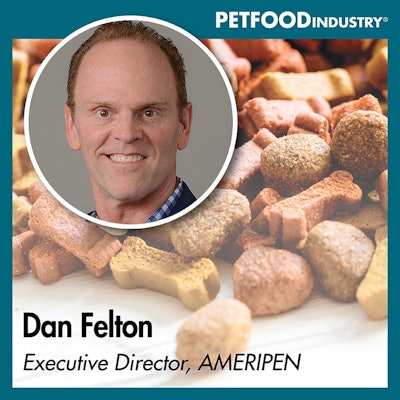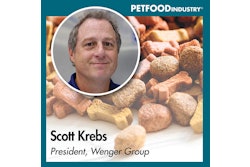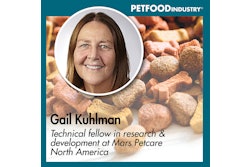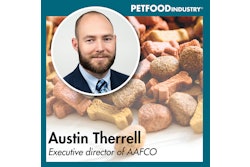
I spoke with Dan Felton, executive director of AMERIPEN, and we took a look at the results of a survey conducted in partnership with PMMI that focused on packaging. We also took a look at the current state of packaging in pet food, and what the future may hold.
The below transcript is from Episode 41 of the Trending: Pet Food podcast, where I spoke with the Executive Director of AMERIPEN, Dan Felton, about a recent packaging survey conducted in partnership with PMMI, and what it means for the future of pet food packaging. You can find the episode at www.PetfoodIndustry.com/trending-pet-food-podcast, on SoundCloud or on your favorite podcast platform. This episode originally aired on August 9, 2023.
A SPECIAL NOTE FROM THE HOST
Hello, podcast listeners! This is your host, Lindsay Beaton, and I'm jumping in to ask a quick favor. I've launched an audience survey for Trending: Pet Food, and I would absolutely love to hear your thoughts on the podcast now that we're nearly 50 episodes in. You can find the survey at www.PetfoodIndustry.com/podcast-survey, And there's also a QR code floating around on the podcast Instagram @trendingpetfoodpodcast, as well as on LinkedIn. The survey will be active through the end of August, and if you could take just five minutes or so — I promise; I took the survey myself to make sure! — to provide your insights it would mean a lot for the future of the show. Thanks so much, and enjoy the episode!
(We want to thank AFB international for sponsoring this podcast. AFB is the premier supplier of palatants to pet food companies worldwide, offering off-the-shelf and custom solutions that make pet food, treats and supplements taste great.)
Lindsay Beaton – Editor, Petfood Industry magazine and Host, Trending: Pet Food podcast Hello, and welcome to Trending: Pet Food, the industry podcast where we cover all the latest hot topics and trends in pet food. I’m your host and editor of Petfood Industry magazine Lindsay Beaton, and I’m here today with Dan Felton, executive director of AMERIPEN, the American Institute for Packaging and the Environment. Hi, Dan, and welcome!
Dan Felton – Executive Director, AMERIPEN
Thank you, Lindsay. Good to be with you.
Beaton: Dan is a well-known leader in the government affairs arena where he’s been for more than 20 years, working within the bottled water, credit card, healthcare and information management industries. He is particularly passionate about environmental, sustainability and packaging issues, and has lobbied extensively in those areas at the state and federal levels. He leads the efforts of AMERIPEN to develop and advocate positions for the U.S. packaging industry on issues related to packaging and the environment, using sound science and a philosophy of material inclusiveness.
AMERIPEN is the only material-neutral packaging association in the United States representing the entire packaging supply chain, including materials suppliers, packaging producers, consumer packaged goods companies and end-of-life materials managers. The Institute focuses on science and data to define and support public policy positions, and its advocacy is based on rigorous research rooted in a commitment to achieve sustainable packaging, and effective and efficient packaging recovery and recycling policies.
AMERIPEN and PMMI, The Association for Packaging and Processing Technologies, recently released “Packaging Compass: Evaluating Trends in U.S. Packaging Design over the Next Decade and Implications for the Future of a Circular Packaging System,” a study to help identify key 10-year trends in packaging design and materials, and the implications of these trends on legislation and the recovery systems for consumer-packaged goods.
This study brings up the perfect opportunity to have Dan on to answer today’s question: What is the future of pet food packaging?
So Dan, I want to start off by giving our audience a background on the study in case they haven't had time to go through it. What was the purpose of the study? Can you walk me through an introduction of it and the methodology of it, things like that?
Felton: Yeah, absolutely, Lindsay. So, AMERIPEN is an advocacy organization, and more often than not whatever we're working on is tied to advocacy and public policy that may implicate the packaging industry in one way or another. One of the things we find in a lot of the dialogue we do with our members and with recycling market development professionals out in the states, and those who manage packaging at its end of life, is that there's often a disconnect between what is happening with that packaging at the beginning of its life when it's designed by packaging engineers and designers and then implemented by CPG companies, and then what happens with it at the end of the life. And we find that there's sometimes a five-, even up to a 10-year gap where the recovery industry is not at the same place that the packaging coming onto the market is, and we can dive into that deeper, but we are interested in closing that gap and if there's a way to close that gap within the consideration of public policy at the state or federal level.
That was the focus of this study, is to take a look at what packaging companies and consumer product goods companies are looking at in terms of the packaging they're thinking of using in the next 10 years, and do we have any stumbling blocks with that as we look at existing public policy or where we might be able to use policy as a lever to help address that packaging and kind of close the gap there? That was really the focus of it. We partnered with PMMI (the Packaging Machinery Manufacturers Institute) and we leveraged first some existing data from Euromonitor International to look at what we are seeing in the 2020 to 2025 timeframe. And then we also conducted a survey with a third-party organization to go out and survey packaging companies, consumer goods companies, government officials actually, and see what we're looking at over the next 10 years. And that was the result of the survey, was part of the study, in addition to this Euromonitor International data that's also included in this study.
Beaton: This study feels really important to me, because I don't know if the gap has increased over the years between what people are asking for and what can be done but I know that now, particularly in the pet food industry, and I'm assuming all consumer packaged goods segments, what people want and what they say they want, and then what the technology is able to deliver, and then what the consumer is willing to do, or the role the consumer is willing to play in seeing that technology through to the end, seems to be disjointed. Like, it is not smooth sailing from start to finish. What were some of your key findings in the study? Did the study bear that out?
Felton: Yeah, I would say the first thing that was very true from the study was this concept that packaging is continuing to shift, right. The packaging we had on the market 10, 20, 30 years ago, when arguably the recycling systems in the United States became more mature, it's changed significantly — and there are strong indicators from the study that it's going to continue to change, as even pet food companies are looking at what they're using five years ago versus what they're using today, and where we think they and others may be headed. That looks very different than it did even a decade ago, much less 20 or 30 years ago. So that is a key finding that we found, that as we're looking at some of the material formats and types of packaging, there are going to potentially be even additional challenges on how to address that packaging once it's out in the market and trying to be recovered, trying to be recycled.
And what can we do about that? You're absolutely right, there are some disconnects. Consumer is king, right? Consumers are going to buy or not buy products, and they're going to adopt or not adopt the packaging. So companies are making shifts based on what consumers want. But then there is this disconnect at the end that we have a curious recycling system here in the United States; some people say it's broken, I don't subscribe to that. I subscribe that it needs to be updated, and we need to do that to help consumers know what to do with the packaging at its end of life.
Beaton: What do you think are some of the key ways to do that? Technology the industry can work on, and the desire is there and the science is there, and people are certainly doing the work to try to make all of these things happen. But you're right, we do have an interesting recycling system in the United States where, depending on where you live, you have different capabilities and different knowledge of where to take things, what to do with various materials. Who do you think should be responsible for that kind of education? Where does that fall? Or where have you seen it fall as the people you work with are trying to make all of this happen?
Felton: Yeah, that's a great question — and a loaded one! Typically, the responsibility has fallen on municipalities and consumers. The municipalities are the ones funding the recycling systems at the local level, and then they're hopefully trying to educate consumers on where they can recycle things, what they can recycle. And, arguably, then with a component of the manufacturers or the brand owners, if you will, helping to identify on their packaging what is or is not recyclable. But there is that disconnect, where, and I can give you a very specific example, where we don't necessarily have the infrastructure in the United States to be able to handle that. Certain types of packaging, or what we need to increase in terms of packaging, recycling, recovery, infrastructure, is a huge issue. We can educate consumers all day long about recycling, but if the infrastructure in a rural area, for example, or the infrastructure to address a certain type of packaging isn't there, all that education is for naught because there's not a path forward. And that's a big thing we see, is that we can do have opportunities to increase infrastructure in the United States, and I'm happy to give you a couple of specific examples if that's helpful.
Beaton: Yeah, I'd love to hear more about that, because you're right. All the education in the world on the consumer end isn't much good if they can't actually put that education into practice. So I'm very interested to hear about who helps the municipalities? Is it organizations like AMERIPEN? Do the packaging companies themselves have opportunities? Are there any inroads you guys can make to help improve infrastructure?
Felton: There are multiple opportunities right now and I'll give you a couple examples. One is, and this is addressed in the report, is this concept that is now coming into the United States called extended producer responsibility or EPR. At AMERIPEN we call it packaging producer responsibility. We have a lot of that in the U.S. already but it's for hard-to-recycle products like batteries, carpet, paint, thermostats, light bulbs. Until a couple years ago we did not have packaging producer responsibility in the U.S. We do now with four laws in place, and part of the intent of EPR is to shift that financial responsibility — sometimes also the operational responsibility — from the municipalities, from the consumers and have industry pay for that. So industry [will] be responsible for the products at their end of life that they have put out into the market. We have four laws in place in the United States, and AMERIPEN has a vision that if a well-structured EPR program for packaging is implemented, that can actually solve a whole bunch of problems. It can educate consumers further, because some of the funding should go towards consumer education; it can go towards funding increased infrastructure, particularly if you think for harder-to-recycle materials, you may be able to put optical sorters out into the recycling facilities, or put more collection depots in a state to take back those materials. Which we believe is great, because the last thing we want is for material not to have a path forward to be recovered and then ultimately, it might be banned. We don't want to see that.
There's another opportunity here on infrastructure, if you think, and the example I'm going to give you is compostable packaging. We have some charts in our study that show sort of that five- and 10-year trend on where packaging shifts might occur based on what packaging manufacturers and brand owners say they're going to be doing. And there's one chart where there's this one line that goes up and off the chart compared to everything else. Well, it's compostable packaging. We have this huge interest over the next 10 years in companies using more compostable packaging. The problem with that in the U.S. [is] we don't have a lot of great infrastructure. Right now, we have a lot of great composting infrastructure in the U.S. for yard waste and things like that. What we don't have is a lot of systems that are willing to take in that compostable packaging as well. So, you have this disconnect. Manufacturers are likely going to be putting a whole bunch of more compostable packaging out in the marketplace. But what are we going to do with it to recover it? This is another example where a focus on funding and infrastructure from industry and others can help make a path forward for that, and that's part of what's included in the study of some of those potential ways to make that happen.
Beaton: Have there been any pain points in shifting some of that responsibility to the industry? Are there financial pain points or operational pain points? Anytime you shift responsibility from one entity to another, there's going to be a little bit of scrambling and definitely some operational changes. So has there been a lot of pushback involved in all of this? Or is the industry ready to take it on and be like, yes, we want everybody to know how to work this technology. We have it, we want to see it through to completion. What's the excitement versus trepidation level?
Felton: Well, I've got to say yes and yes to your question. Has there been pushback? And has there been, you know, embracement or adoption? Yes. And by that, I mean, you know, 10, 12 years ago, this conversation came up in the U.S., and quite candidly, from producers and many people it was a flat “No.” We've had these programs in Canada for 20 years, in Europe for 30 years, but the message in the U.S. was “No, absolutely not.” That has shifted. Now, generally speaking, industry has embraced this concept, probably to some extent being pushed to do it. It's here, it's coming, laws have been passed, so we better get off our butts and figure it out. But even with that, then yeah, there's absolute trepidation, because this is new to the United States. It's not necessarily new to some of these companies who are multinational companies. But this will impact even companies that are strictly U.S.-based who've never had to deal with something like this. So a lot of trepidation, uncertainty, as these laws are now being implemented — and none of them are actually in full effect.
But then also, within industry, there's competing interests on how the program should be run, who has access to the materials, how the fees are going to be structured. It'll all get worked out because it has to, you know, the laws are here, they're not going away, we're probably going to have some more laws. But it's a different type of trepidation or a different type of pushback now, as in everybody needs to be a stakeholder at the table to get these programs, right, and to make sure their interests are considered as they're stood up.
Beaton: Are the laws and the upcoming programs similar enough to those happening in other countries that we can maybe learn from some of their early mistakes? Or are they different enough that it feels like everybody is working from scratch?
Felton: Yeah, that's a great question. And I think it's a combination of both, Lindsay; definitely there's lessons to be learned from these programs that have been around 20 — in some instances, almost 30 — years now. But even those programs are continuing to evolve. And when we come back to the focus of the study, is that the materials that were on the market when those programs were first developed and implemented in other countries look very different than what we have out on the market today and where manufacturers and brand owners are even looking to shift in the next five to 10 years.
So yes, there are lessons to be learned but as those programs continue to evolve as well, we also have a challenge in the U.S. If you look at the EU and how many nations there are in the EU, and then you look at the United States, we have 50 states and some territories that arguably have all their own systems in place that even then get more local. So there are challenges here in the U.S. which I think it's fair to say no country that's got packaging EPR in place has ever had to deal with. There are going to be some things in these programs in the U.S. that are going to be unique. And actually, I'm a little proud to say from America’s perspective, there's some things that we've implemented in these laws which are now in the United States that some others and other countries are looking at and saying, “Hey, that was actually good idea. Maybe we should look at that.” So it goes back and forth. But I think others are going to learn from what's done in the United States and a lot are paying attention to see how it's going to come to fruition here.
Beaton: Going back to the study, was there anything surprising that came out of that? Or did everything pretty much pan out the way you were expecting it to when you started surveying people?
Felton: Well, I think the compostable thing, we knew that people were looking at trying to move to more compostable packaging, because the reality is there's either self-imposed goals or there's participants. For instance, in the Ellen MacArthur Foundation, which has goals, but if you’re a company that's coming out as part of their sustainability initiative, saying, “Hey, I am going to have my packaging be 100% recyclable, compostable, or reusable by 2025 or 2030,” how are you going to get there? The reusable is not a mature market in the U.S. It's arguably not really a mature market anywhere in the world. It's moving, becoming more common, but it's not there yet. Recyclable — we could have a whole ‘nother podcast about recyclable, and how do you get to be considered recyclable and some of the challenges there. And maybe compostable is sort of this unchartered frontier where people can go and look at moving towards compostables, but we were surprised, and like I said earlier it just went off the charts. I think that was one surprise.
The other two big takeaways from the report were not surprises; I think they made sense. And those are a push to use more recycled content — and that is not surprising, and the results of this study codified what we knew already in terms of more companies wanting to voluntarily use more recycled content rather than virgin materials, or they're being pushed by policymakers to have to use more recycled content. Not a surprise, though. The other one, I think, not a surprise, is more use of flexible packaging. And that, in my view, hits directly towards an example in the pet industry and the amount how they're shifting to use more flexible packaging. Not a surprise, I think maybe a little bit of a surprise that we see more, within the flexible packaging space, we see more companies probably trying to make a shift from multi-layer flexible packaging to monomaterial. And that's sort of getting in the weeds, but that we did see a little bit more of a focus on companies probably moving that direction. Again, probably not surprising. Those are the three big takeaways, one very surprising to us, the other not so surprising with some nuances within them.
Beaton: It sounds like we are firmly in the thick of all of this, in terms of: The laws are partially implemented, they're new, we're in the middle of this big technology shift and what people are asking for … all of the consumer packaged goods segments are probably grappling with a lot of the same things that the pet food industry is grappling with in terms of recyclability and sustainability and eco-consciousness. And packaging is just such a visible way to market that idea that I think, unfairly or otherwise, packaging has a lot of eyes on it right now, maybe more than it ever has, just because it's such a physical way to implement all of this stuff. As you're in the thick of all of this right now, what are the biggest challenges that you're seeing the packaging industry deal with?
Felton: I've been calling it the packaging precipice we're standing at right now. There’s a whole lot coming at us, as you point out, and particularly over the last three years or so, and there are some challenges. And I think one of them is to make sure that, as policymakers are moving forward with laws related to packaging, that they not ultimately result in packaging being deselected — that's a fancy way to say packaging being banned. If you look at flexible packaging, whether it be films or paper or a combination of paper and films, that packaging is there for a reason. And we have a challenge about trying to point out the value of packaging to policymakers and others and consumers, as sometimes packaging is being attacked or sometimes it's made out to be a plastics issue. This is not just about plastics, it's about all sorts of different materials.
But that is a challenge for us is, as much as you point out that it's very visible, it’s very important to companies that their packaging brand, the products within the packaging … but to be able to balance that, I hear from members of mine that packaging within the whole scope of the product development, and moving a product in the market, they say it's like 3% to 5% of the overall total cost of a product. That's pretty small. If you think about all the other things that go into these products, packaging is 3% to 5%. And yet, as you point out, people are looking at it and it's what everybody sees. COVID even exacerbated that further, so much more packaging in the home that people weren't previously seeing. That's a huge challenge for us. So, as we work on policies, the other thing AMERIPEN’s passionate about is the value of packaging: Why designers, why companies, packaging manufacturers are making the choices they're making to get those products to customers safely, securely. And that's a challenge we have, is communicating that as well as balancing that with these policies we're seeing.
Beaton: I think it's interesting to talk about the conversations that are happening within the industry and between industry and regulators, because we focus on the end consumer a lot and their needs and their wants. And they're a huge driving force in change when it comes to consumer goods. But it's not just complications with them, it's among the packaging companies, like you said, where the finances are going to come from and how these laws are going to affect them, and then trying to educate within the packing industry and the people who work with the packing industry from a government perspective, or a regulatory perspective, just making sure everybody is on the same page. Is that something that you guys have a pretty heavy hand in?
Felton: I think it's mediating or it's collaborating or bringing stakeholders together. All those entities you talked about are all subject matter experts at some level. Some may be packaging designers and engineers who are subject matter experts, some may be end-of-life materials managers, recyclers, if you will. We have policymakers who are looking for information from all those subject matter experts, and that's something AMERIPEN, across its membership, and with a whole host of other stakeholders we work with outside of our members, to try to bring those people together. An example of that is: We have a task force that is made up all of non-AMERIPEN members. They're not members of ours, but people who are out in the states and on a regional basis, trying to increase recycling, not only for packaging, but a whole host of other products. But that's an example where we facilitate, and I guess you could say mediate, discussions with those people to try to solve problems for everyone, lift all boats.
The other example I use is how deeply embedded right now we are in the regulatory process. We got all these new laws coming at us, and I sort of, in a way, I think, panicked about a year ago. I said, “Man, we've got everyone thinking AMERIPEN’s going to be testifying at hearings before laws get passed, but are we supposed to be engaging at the same level on implementation of these laws?” which arguably sometimes on the back end is a whole bunch more mediation. It's one thing to get a bill across the finish line, it's one thing to get it stood up and running successfully. And that's something now we've been very focused on, and the answer was, yeah, we got to be on that side of the equation too. And happily, we're having a lot of great conversations that are bringing all those people together. I firmly believe that if we all come to the table together, we can solve some of these super complicated problems, versus just everyone's digging in and taking their own position. And sometimes not having that negotiation, if you will, with all the other stakeholders, you notice all these problems for everybody.
Beaton: Based on everything we've talked about, and the survey, I want to zoom in on pet food to wrap up this conversation. What do you believe are the next steps in the packaging journey for pet food? So, if pet food packagers are listening, if manufacturers who deal with packaging are listening, anybody who has anything to do with packaging, what should we all expect next?
Felton: The pet food industry, I think, is a great example of an industry that has shifted their packaging to meet the needs, either to take into consideration the new types of packaging formats that are available (whether that be pouches, or moving from pans to pouches, or from something more rigid to something that's more flexible), I think the pet industry is a great example that has adopted that, whether it be because the use of those different new emerging packaging materials and formats is a better sustainable choice, or it's what consumers want. So if anything, I would applaud the pet food industry for doing that.
And then I would say, here's an opportunity to be engaged. Because in some instances the pet industry is also using some more challenging packaging formats, and I go back to that concept that the last thing we want to see is if you've made the smartest choice for your packaging, all things considered — and that could be transportation, it could be consumer convenience, it could be reducing materials — is that if your pet food company has done that, then how do they ensure that that packaging can have a successful life and maybe on to its next life, whether that's back into packaging or whether that's into another product? And that is where there's a great opportunity right now, in my view, for those from the pet food industry. If you're not already engaged, get engaged. Be aware of the laws that are happening in your states, be aware of if you are going to be considered a producer, a brand owner, who's going to start having to pay into these systems as soon as 2025.
For those who are hearing this podcast, if you're not already having these discussions and paying attention to what's happening, now's a great time, because you can actually still influence the outcome. An example of that is this concept that states are developing these statewide recycling lists that will help put some uniformity out into these programs as they're stood up at the state level. You want your packaging on that statewide uniformity, so it doesn't mean it's going to be bad if it's not, but you're going to have a better path forward and probably pay lower fees if you can make an argument to have your material included on these collection lists. And that's just one example how engaging now is going to shape a better outcome for the pet food industry later on.
Beaton: I think that is all excellent information and excellent advice, and I really want to thank you for coming on and talking about both the study and the future of packaging with me today. There's so much happening from the technology side, the trends side, the consumer side, there's a lot to unpack — no pun intended.
Before we go, let's do a little plug. Where can people find more information about you and more about AMERIPEN?
Felton: Yeah, thank you, Lindsay. And the best way is to go to www.AMERIPEN.org. From there, you can find out more information about our industry, about our membership. Right at the top of the website there's a scrolling banner and about two or three scrolls into that as it shifts in front of you you'll see the Packaging Compass, big graphic on the top of our landing page. Click on that, that'll take you right to the Packaging Compass where you can download the executive summary and the full report, and then even search within that report. You'll find some actual references specifically to pet food, dog and cat food, within the scope of the broader study. So that's my recommendation; go to our website and learn a whole lot more.
Beaton: Excellent. That is it for this episode of Trending: Pet Food. You can find us on www.PetfoodIndustry.com, SoundCloud or your favorite podcast platform. You can also follow us on Instagram @trendingpetfoodpodcast. And if you want to chat or have any feedback, I'd love to hear from you. Feel free to drop me an email: [email protected]. And of course, thanks again to our sponsor AFB International, the premier supplier of palatants to pet food companies worldwide offering off-the-shelf and custom solutions that make pet food, treats and supplements taste great. Once again, I'm Lindsay Beaton, your host and Editor of Petfood Industry magazine, and we'll talk to you next time. Thanks for tuning in!

















